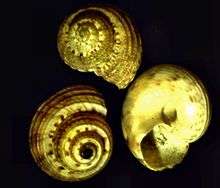Pseudominolia articulata
Pseudominolia articulata is a species of sea snail, a marine gastropod mollusk in the family Trochidae, the top snails.[2][3]
| Pseudominolia articulata | |
|---|---|
 | |
| Several views of a shell of Pseudominolia articulata | |
| Scientific classification | |
| Kingdom: | Animalia |
| Phylum: | Mollusca |
| Class: | Gastropoda |
| Clade: | Vetigastropoda |
| Order: | Trochida |
| Superfamily: | Trochoidea |
| Family: | Trochidae |
| Genus: | Pseudominolia |
| Species: | P. articulata |
| Binomial name | |
| Pseudominolia articulata | |
| Synonyms[2] | |
| |
Description
The height of the shell attains 6 mm, its diameter 7 mm. The shell horn is colored with spots of brown, which equally divide the space with ground color on the spiral keels. There is a line of commashaped spots which extend from the summit into the flat space anterior to it. The 2½ white, nuclear whorls are small, well rounded and smooth. The shell contains 3⅓ postnuclear whorls. The first two are marked by three strong lamellar spiral keels, the last by four between the summit and the periphery. The keels are equally spaced, the fourth being at the periphery, while the first is a little further from the summit than it is from its neighbor anteriorly. In addition to the spiral sculpture, the whorls are marked by very slender, closely spaced, axial threads which are best developed in the spaces between the spiral cords. The periphery and the base are well rounded, the latter broadly umbilicated and marked by 10 depressed spiral cords which are truncated posteriorly and slope gently anteriorly. The whole has the appearance of a series of imbricating bands. In addition to these, there are three cords in the umbilicus wider and stronger than those on the base. These cords are crossed by closely spaced riblets which give them a peculiarly notched appearance. The aperture is subcircular. The outer lip is rendered sinuous by the spiral keels. The slender columella is strongly curved. The parietal wall is covered with a thin callus.[4]
Distribution
This marine species occurs off Cape of Good Hope, South Africa.
References
- Gould, Proc. Bost. Soc. Nat. Hist., vol. 8, p. 15, 1861.
- WoRMS (2012). Pseudominolia articulata (Gould, 1861). Accessed through: World Register of Marine Species at http://www.marinespecies.org/aphia.php?p=taxdetails&id=567723 on 2012-11-23
- Herbert D.G. (1992). Revision of the Umboniinae (Mollusca: Prosobranchia: Trochidae) in southern Africa and Mozambique. Annals of the Natal Museum 33(2):379-459.
- P. Bartsch (1915), Report on the Turton collection of South African marine mollusks, with additional notes on other South African shells contained in the United States National Museum; Bulletin of the United States National Museum v. 91 (1915)
External links
- To World Register of Marine Species
- "Pseudominolia articulata". Gastropods.com. Retrieved 16 January 2019.